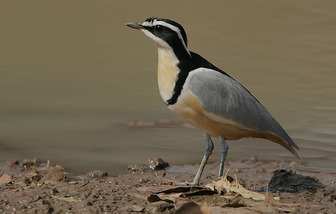Egyptian Plover
It is also sometimes referred to as the Crocodile Bird because it is famous for its symbiotic relationship with crocodiles . According to a story dating to Herodotus, the crocodiles lie on the shore with their mouths open, and the plovers fly into the crocodiles' mouths so as to feed on bits of decaying meat that are lodged between the crocodiles' teeth. The crocodiles do not eat the plovers, as the plovers are providing the crocodiles with greatly-needed dentistry. Two prominent ornithologists have supported this story anecdotally, but the behaviour has never been authenticated .

Original source: Steve Garvie from Dunfermline, Fife, Scotland
Author: Steve Garvie from Dunfermline, Fife, Scotland
The Egyptian Plover is classified as Least Concern. Does not qualify for a more at risk category. Widespread and abundant taxa are included in this category.
The Egyptian Plover, Pluvianus aegyptius, is a wader, the only member of the genus Pluvianus. Formerly placed in its own monotypic family Pluvianidae, it is now regarded as the sole member of the subfamily Pluvianinae, part of the pratincole and courser family, Glareolidae. It is also sometimes referred to as the Crocodile Bird because it is famous for its symbiotic relationship with crocodiles (National Geographic 1986). More
The Egyptian Plover is a wader, also called Crocodile Bird for its symbiotic relationship with crocodiles. According to a story dating to Herodotus, the plovers fly into crocodiles' mouths so as to feed on bits of decaying meat that are lodged between the crocodiles' teeth. Egyptian Plover is a localised resident in tropical sub-Saharan Africa. It breeds on sandbars in large rivers. It is a striking and unmistakable species. More
The Egyptian Plover is a localised resident in tropical sub-Saharan Africa. It breeds on sandbars in large rivers. Its two or three eggs are not incubated, but are buried in warm sand, temperature control being achieved by the adult sitting on the eggs with a water-soaked belly to cool them. If the adult leaves the nest, it smooths sand over the eggs, though if it is frightened the job may be hasty. More
The Egyptian plover is either a very brave or very stupid bird. In the wild this bird is found in close association with the Nile crocodile. The birds frequently feed within the mouth of the crocodile removing and eating meat from between the crocodile’s teeth as well as parasites such as leaches from the crocodile’s tongue. More
Egyptian Plovers are beautifully colored birds in the courser family. They are sometimes called Crocodile Birds. The Egyptian Plover lives in Sub-Saharan Africa and are a target species for birders visiting The Gambia. More
The Egyptian plover is native to sub-Saharan Africa, lowland tropical rivers with bars of sand and gravel. This bird can often be found around human settlements near rivers. Natural diet: The species mainly eats insects, and it also eats worms, mollusks and seeds. Size / weight range: The Egyptian plover grows to be 7 to 8 inches long and weigh 45-65 g (1.6-2. More
The Egyptian Plover, Pluvianus aegyptius, is a wader, the only member of the genus Pluvianus. Formerly placed in its own monotypic family Pluvianidae, it is now regarded as the sole member of the subfamily Pluvianinae, part of the pratincole and courser family, Glareolidae. More
Egyptian plover in the mouth of a crocodile. Image from Warren Photographic. If big multinational companies (MNCs) are the crocodiles of your industry, instead of fighting with them head on why don’t you become an Egyptian plover? This tiny bird lives in a symbiotic relationship with the crocodile, preying on the parasites that feed on and can be potentially harmful to the reptile. More
Egyptian plover wading in shallow water© David Tipling / naturepl.com Egyptian plover portrait© Michel Gunther / Biosphoto Egyptian plover with view of breast feathers© David Tipling / naturepl.com Egyptian plover standing near water© Stephan Bonneau / Biosphoto Egyptian plover foraging in sand© Tony Crocetta / Biosphoto Egyptian plover ruffling feathers© Alan Greensmith / www.ardea.com Egyptian plover with wet feathers in order to cool chick© Bruce Davidson / naturepl. More
Nile Crocodile (Crocodylus niloticus) with Egyptian Plover or Crocodile Bird (Pluvianus aegyptius) - digital reconstruction of popular myth attributed to Herodotus, 5th Century BC. Africa WP00955. Nile Crocodile (Crocodylus niloticus) with Egyptian Plover or Crocodile Bird (Pluvianus aegyptius) - digital reconstruction of popular myth attributed to Herodotus, 5th Century BC. More
KUSA - The Egyptian Plover is a shorebird that is native to the hot sandy beaches of Sub-Saharan Africa. Advertisement KYLE'S KRITTERS: Egyptian Plover These birds love the heat and rely on the intense sun to raise their young. Adult birds will dig room under a thin layer of sand to lay their eggs & then, they'll leave. More
Family : Glareolidae
Genus : Pluvianus
Species : aegyptius
Authority : (Linnaeus, 1758)

